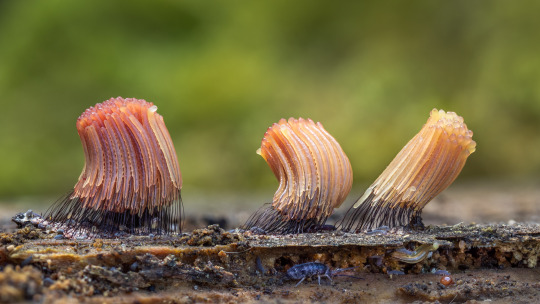#comatricha species
Photo

Arcyria denudata.
Macro Photos by Barry Webb Highlight the Spectacular Diversity of Slime Molds

Comatricha nigra

Comatricha species

Cribraria aurantiaca group

Stemonitis and insects
#barry webb#photographer#slime molds#fungi#fungus#macro photography#nature#arcyria denudata#comatricha nigra#comatricha species#cribraria aurantiaca group#insects
526 notes
·
View notes
Text

young Comatricha nigra by naturefold
#comatricha#a weird colour 4 this species but the experts didn’t dispute the id in the comments#comatricha nigra#naturefold#myxomycota#slime mold#slime mould#forest floor#mycology#myxomycology#myxomycetes#protists#microbiota#biology
287 notes
·
View notes
Photo

Slime Mold, Comatricha species
67 notes
·
View notes
Text
Self-Taught Nature Photographer Alison Pollack Tracks the Fascinating Fungi of Northern California
Stemonitis. All photographs by Alison Pollack
Avid photographer and retired environmental consultant Alison Pollack documents the fascinating phenotypes of mushrooms and slime molds she encounters on hikes in northern California. Her images show shaggy white Comb Tooth fungus (Hericium coralloides), Stemonitis slime molds that wouldn’t look out of place on the dessert menu of an experimental restaurant, and Comatricha that bear a strong resemblance to urban lamp posts. Recently, the north Bay Area-based photographer shared with the Marin Independent Journal that she has had a longtime interest in hiking and mushrooming, but has grown more focused on fungi photography in the last two years. You can follow along with Pollock’s findings, and help her identify unknown species, on Instagram.
Tyromyces chioneus
Hericium erinaceus
Chlorociboria aeruginascens
L: Comatricha / R: Hemitrichia calyculata
Crepidotus mollis
Physarum viride
Trametes versicolor
Mycena
0 notes
Text
Self-Taught Nature Photographer Alison Pollack Tracks the Fascinating Fungi of Northern California
Stemonitis. All photographs by Alison Pollack
Avid photographer and retired environmental consultant Alison Pollack documents the fascinating phenotypes of mushrooms and slime molds she encounters on hikes in northern California. Her images show shaggy white Comb Tooth fungus (Hericium coralloides), Stemonitis slime molds that wouldn’t look out of place on the dessert menu of an experimental restaurant, and Comatricha that bear a strong resemblance to urban lamp posts. Recently, the north Bay Area-based photographer shared with the Marin Independent Journal that she has had a longtime interest in hiking and mushrooming, but has grown more focused on fungi photography in the last two years. You can follow along with Pollock’s findings, and help her identify unknown species, on Instagram.
Tyromyces chioneus
Hericium erinaceus
Chlorociboria aeruginascens
L: Comatricha / R: Hemitrichia calyculata
Crepidotus mollis
Physarum viride
Trametes versicolor
Mycena
from Colossal https://ift.tt/2UKmk1D
via IFTTT
0 notes
Text

Comatricha nigra by Sarah Lloyd
“Most slime mold species change considerably in colour, shape, and size as they develop. The cream-coloured fruiting bodies in the foreground started to ooze out of the log right next to the pinkish-coloured ones that appeared the days before. I checked the size and decoration on the spores, the extension of the columnella (extension of stalk inside the spore mass) and the capillitium microscopically and, to my surprise, it turned out to be Comatricha nigra. C. nigra is one of the most common Comatricha species that is usually quite easy to identify by its slightly sub-globose sporotheceae (‘head’) on long stalks, but like all slime molds, it is very variable.”
#sarah lloyd#comatricha nigra#comatricha#myxomycota#slime mold#microbiota#microorganisms#microbiology#macro photography#slime#slime mould#mold#protists#fungi#myxomycology#myxomycetes#biology#nature facts
79 notes
·
View notes